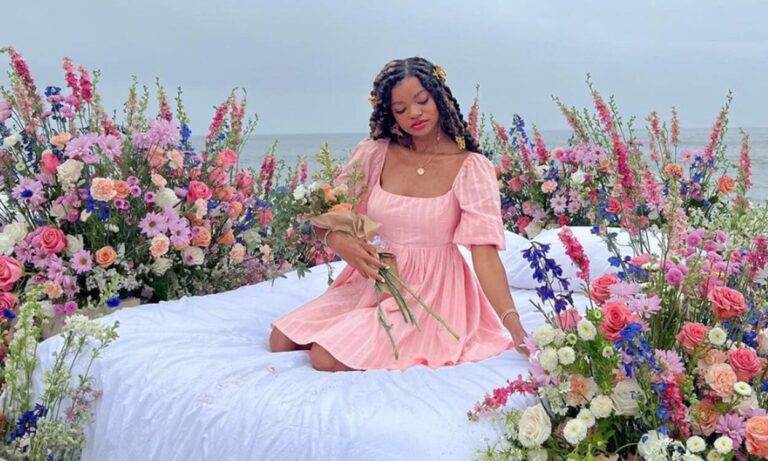What is coquette? A hyper-feminine fantasyland or an exclusive members only club?
Internet subcultures such as gothcore, clowncore, and honeycore have all enjoyed their days in the sun, imprinting their signature style on For You Pages (FYPs) and themed ASOS orders. Soon, however, these trends are bound to fade into the peripheral, shifting from a viral hashtag on TikTok to an obscure subreddit thread—except, of course, for one: coquette. Is this an established aesthetic that celebrates female empowerment? Or is it yet another problematic members only club that fetishises hyper-femininity?
What is the coquette aesthetic?
For those of you who might be unfamiliar with the coquette aesthetic, let me walk you through the style’s origin. Imagine that it’s 2010, Gossip Girl is humming along in the background, you’ve logged out of MSN and you’re sitting down at your laptop, prepped and pumped to dive head first into your favourite online rabbit hole: Tumblr.
While scrolling through selfies of Kylie Jenner with dip dyed hair and varying sexual content, you’d probably come across a barrage of girls sporting dresses, frills, lace, and a whole lot of pink. The coquette style has been defined by resident subculture expert hub Aesthetic Wiki as “a broad term for hyper-feminine aesthetics that incorporate elements of youth and teenage girlhood.” Of course, within this umbrella term, there are a vast number of subgenres, such as dollette, lolita, fairy, forest girl, and—most controversially—nymphet.
View this post on Instagram
While the coquette aesthetic carries its own set of negative connotations, the nymphet look has been criticised by academics and civilians alike for decades. Unlike lolita —which, having originated in Japan, favours a Victorian-era inspired brand and actively tries to disassociate itself from sexualisation—the nymphet aesthetic is actually based upon the novel Lolita by Vladimir Nabokov and is widely considered as a term for “sexually precocious young girl.”
Lolita follows the story of a middle-aged professor who becomes obsessed with a 12-year-old girl. The child also happens to be the daughter of the protagonists’ supposed love interest. The highly controversial 1955 novel perpetuated and combined motifs and themes of young girls and eroticism, particularly from the older male gaze.
While many online reviews (such as NPR’s in 2006) have commented on the inappropriate nature of Nabokov’s prose, they almost always conclude by celebrating the novel for its complexities—in turn, prioritising its literary importance over the harm the author’s protagonist may have caused.
While attempts have been made to reclaim the nymphet term, re-centring the aesthetic around positive femininity has resulted in the persistence of the core origins behind the style in promoting the hyper-sexualisation of young girls.
“Graceful, dreamy, delicate”
While the nymphet aesthetic harbours negative societal commentary, the coquette style has proved to be incredibly valuable to a number of young girls. Individuals who identify with this aesthetic online often use their platforms to promote embracing one’s femininity—reclamining fashion trends as empowering rather than allowing internalised misogyny to stop them in their tracks.
With a pair of Lana Del Rey-esque sunglasses in one hand and a Lily Rose Depp corset in the other, many have found comfort and happiness in expressing themselves through this bubblegum lens. Currently on TikTok, #coquette boasts 4.7 billion views—spanning across categories such as fashion, lifestyle, accessories, and homeware.
Leading the pack is creator Kellen-Pippa Beckett, or as she’s better known to her followers, @coqxette. Beckett has amassed over 211,000 followers on the video-sharing platform and dedicates her page to all things coquette, be it outfit inspo, Gilmore Girls content or “coquette big sis” advice tips.
SCREENSHOT recently spoke with Beckett about how she initially stumbled across the trend. “I first heard the term describing the style on TikTok around a year ago, probably this time last year. And I was so intrigued that we finally had a name for this style or fashion that I wanted to take part in that ‘genre’ of video and make my own,” the influencer explained.
Beckett went on to add: “I love the plain femininity of it all. I know I have to be careful when putting a label on what things are feminine, but I also love how it’s an aesthetic genuinely anyone can enjoy. It makes me feel empowered and happy to be a woman but I also love all of the things visually. I love the colours and delicate themes, the music that’s associated with it. The fashion. I love it all.”
Another platform where the subculture is rife is Etsy. A quick scroll through the chaotic marketplace and you’ll come across pearly heart earrings, lace gloves, and Renaissance corsets—in other words, a perfectly curated coquette aesthetic starter pack.
Bella, or t0othfairyz as she’s known on Etsy, sells a number of coquette and dollette themed items on her page, ranging from slip dresses to ruffle embroidered lingerie. The vendor told SCREENSHOT, “I guess the main exposure came from TikTok, as well as Pinterest. But I have always enjoyed it since I was younger, only now am I getting back into it again! I enjoy the embracement of femininity and I love the light colours.”
Such is its popularity that beauty and fashion publications such as Glamour have even dedicated entire features to the trend filled to the brim with any and all products a coquette newbie might need to partake in this soft and delicate dreamland.
Why is the coquette community lacking in diversity?
Pastel pinks aside, it’s also incredibly important to recognise the problems within this community and the ways in which it can not only exclude others, but perpetuate toxic ideals.
Cherwell, Oxford University’s student newspaper, released an article in January 2022 examining The Dark Side of Coquette. The publication noted, “Hyper-feminine fashion has been called out on social media extensively for failing to include people of colour and a range of body types—to the point where some believe they encourage disordered eating and unrealistic standards.”
We sat down with college blogger, influencer, and coquette-aficionado Chazlyn Yvonne who spoke about her thoughts regarding the lack of diversity within this aesthetic, explaining, “The coquette style or community online is one of my favourite spaces, however, it is dominated by non-BIPOC individuals.”
View this post on Instagram
Yvonne continued: “Many people believe that coquette, along with other hyper-feminine styles are supposed to have a certain proximity to whiteness in order to achieve the aesthetic. Eurocentric features are often associated with coquette fashion which makes it lack diversity even more.”
View this post on Instagram
The blogger also mentioned the crucial need for greater representation within these online subcultures. “When you go on Pinterest and type ‘coquette aesthetic’ you will only see one type of person,” she said. “This is why I and several other black creators have made it our mission to represent BIPOC online.”
“I never had someone who looked like me in this style to look up to, which is why I aim to inspire girls to embrace their femininity. While it has definitely gotten better, there still is so much change that needs to happen,” Yvonne concluded.
Indychloe is another highly popular coquette TikToker who, as a woman of colour, has helped cultivate greater diversity among these often highly-exclusive aesthetic communities.
@indychloe @fancytiktokbygab 😔🫶🏽🎀 #girlytok #dollette #coquette #gabidemartino
♬ weak speed - ☁️
TikToker Beckett also recognised that these issues continue to exist within the swathe of coquette-based influencers online—particularly when it comes to visual-first platforms like Pinterest, where inclusivity almost always falls by the wayside.
“In my opinion, the community itself has a lot of work to do when it comes to inclusion and diversity,” Beckett admitted. “When I first discovered the aesthetic I found little to no diversity, and only the traditional ‘skinny white girl’ on Pinterest. I think it’s wrong and disgusting because anyone and everyone can love the style. I suffer with body issues myself which I don’t mind speaking up on and, as a community, its views towards body image and the ‘ideal’ body type to fit into the coquette aesthetic repulses me.”
“As the months go on I’m starting to see so much more inclusion as people start to realise that it’s an aesthetic and style which absolutely everyone can enjoy. Not just a minority that Pinterest says can. But I think we have a long way to go before it feels like everyone can be happy, not feel judged and feel included.”
As explored in the aforementioned article in Cherwell, regardless of the reasons for liking or choosing a certain style, “policing how women choose to express themselves and what makes them feel good is even less empowering.” Fashion should always be inclusive.
So, is gen Z the answer?
Other recent TikTok trends and aesthetics such as princesscore have proved overwhelmingly powerful in promoting inclusivity and encouraging marginalised individuals to embrace their inner royalty.
It truly seems as though gen Zers have a firm handle on identifying weak spots among mainstream fashion trends and using social media to create a far more expansive space for people to freefall into their most authentic selves: pearl encrusted lingerie, daisy printed stockings, and everything in between. While social media is undoubtedly heavily flawed, it’s hard to deny the good it can also do when utilised correctly.
In February 2022, Grazia defined the coquette aesthetic as a much-needed gen Z reinterpretation of a historically negative trend. The magazine noted: “The contemporary reiteration of the coquette is more inclusive and empowering. It is more about embracing the shades of feminine beauty than sexualizing innocence.”
“Ultimately, coquette is not just a trend but a lifestyle being adopted by many as it has the idea of self-love attached to its core. The coquette way of life is almost like you’re sending love letters to yourself regularly and romanticising the different facets of life as a whole,” the publication concluded.
With all of this in mind, what are your thoughts on this divisive yet unwavering aesthetic? Should coquette be left in the early 2000s? Or should it be embraced by young individuals revolutionising the ways in which we think about femininity? You have the power to decide.






